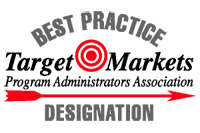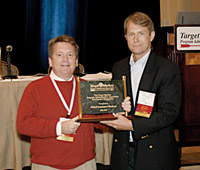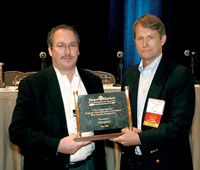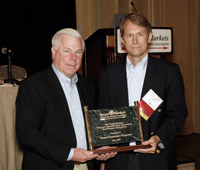 |
 |
 |
Special Section Sponsored by Target Markets Program Administrators Association Program Managers Earn Best Practice Designation Participants must complete six steps By Phil Zinkewicz “How’m I doing?” Ed Koch, elected Mayor of New York City in 1977, asked that question of city residents at almost every photo op during his first term of office. (He actually served three terms.) Whether it was when coming upon a group of his neighbors where he lived in lower Manhattan, riding the subways with fellow straphangers or walking across the Brooklyn Bridge with people trudging to work during a subway strike, the colorful Koch asked, especially if there was a news camera nearby, “How’m I doing?” of the voters who put him into office. Usually, the answer was a resounding, “Just fine!” Now, that question may have been merely a public relations line to convince voters that Koch valued their opinions. Or it may have been a sincere attempt at finding out whether voters did indeed approve of his performance. Nevertheless, it is a question that we all must ask from time to time—of ourselves, the people we work with and our peers. The term “best practices” is used a great deal these days in the world of big business in general and in the insurance industry in particular. It is a management idea that asserts that there is a technique, method, process, activity, incentive or reward that is more effective at delivering a particular outcome than any other technique, method, process, etc. The idea is that, with appropriate processes, checks and testing, a desired outcome can be delivered with fewer problems and unforeseen complications. In short, it is the most efficient and most effective way of accomplishing a task, based on responsible procedures that have proved themselves. Throughout the insurance industry, one can find “best practices” standards that apply to particular areas of expertise—underwriting, claims handling, marketing, customer service, and the list goes on. Last year, the Target Markets Program Administrators Association (TMPAA) developed its best practices evaluation for the purpose of establishing a new designation for program administrators only. Said Ray Scotto, TMPAA executive director: “Our association is dedicated to serving the interests of the program specialist. A core element of the association’s mission is to promote excellence for this most elite segment of insurance intermediaries, managing general agencies and program administrators.” The first three recipients of the TMPAA Best Practice Designa-tion were Distinguished Programs, Professional Underwriters and The Mattei Companies. This year’s designees are Venture Insurance Programs, Thomco and Allied Insurance Brokers. The six steps towards achieving the TMPAA Best Practice Designation are: application/survey; confidentiality/evaluation waiver; on-site evaluation/consultation; evaluation/consultation recommendation; best practice committee review; and TMPAA designation. Scotto said it is important to recognize that only the “program business function” of agencies applying for the designation will be evaluated for this designation. The evaluation process begins with completion of the best practices survey, which provides information about an agency’s program business operations and allows for greater efficiency during the on-site evaluation. Members pursuing the designation will have to sign the confidentiality waiver, which protects the member applicant and the evaluation entity. The on-site evaluation is then scheduled. An evaluation checklist is provided to each applicant after submission of the best practices survey. The checklist details the information and documents that will be needed at the time of the on-site visit. If the evaluating entity recommends the TMPAA designation for the member applicant, the evaluation summary will be provided to the Best Practice Committee for approval. Once the approval is granted, the member agency will be provided the TMPAA Best Practice logo seal for inclusion on the agency Web site. Plans for press releases, inclusion on the TMPAA Web site and notification in the TMPAA newsletter will be discussed with the agency. The TMPAA Best Practice Designation will remain in effect for a period of two years, with a re-certification paper review after the first completed year. The certification process will need to be repeated after a period of two years. “The association has taken some important steps toward raising the expectations for program business operations,” said Jack Russell, executive director of Fireman’s Fund Specialty Programs and chairman of the TMPAA Carrier Committee. “Recognizing the expertise of program specialists and acknowledging the administrators who run successful program operations will not only continue to provide excellence in this industry segment, but also will provide important information for program markets as they seek partners with whom to do business.” “Venture Insurance Programs has always strived to provide best in class solutions for the industries it serves,” said Philip J. Harvey, president of Venture and one of the designees. “This designation from Target Markets demonstrates the success of our approach, our systems and, most important, our people. We’re honored to be one of the first program administrators chosen for this prestigious designation.” “We’re proud to have been recognized for the quality of our operations,” said Marty O’Brien, president of Allied Insurance Brokers, in an interview with Rough Notes. “This designation is another step forward in having the insurance industry in general recognize the valuable and professional role that program underwriting managers provide. The establishment of a best practices designation in our industry is important to create greater confidence and credibility to this industry segment.” The third recipient of the Target Market Best Practice Designation is Thomco. Greg Thompson, president and chairman of Thomco, is also president of the Target Markets Association. “This designation is not only important to those of us who have received it, but it is also important to the program administration industry and our association as well,” he said. “The elaborate process that goes into choosing recipients tells our carriers that we will strive to bring to the industry the best of the best. Moreover, it sets the criteria for our members who are striving towards the kind of excellence represented in the designation. Our members represent different niches and different industries. The best practice designation establishes that we have internal controls in place that say we’re better than average. These controls relate to our underwriting posture to make certain that we are not exceeding our carriers’ appetites. The controls relate to our accounting procedures and to our policy issuance performance. For younger program administrators just coming into the business, this designation is a roadmap to success. At Thomco, we’re very proud to have received this designation and we will continue to live up to the high standards it represents,” said Thompson. In a sense, then, the new TMPAA Best Practice Designation is a way for association members to ask the question, “How’m I doing?” And, for those who have already received the designation, the answer is, “Just fine!” → |
 |
|
||||||||||
|
||||||||||||



